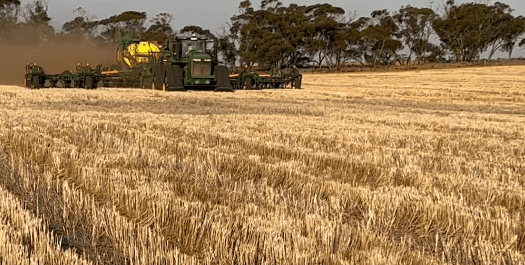
Field peas are planted into wheat stubble at Hopetoun in Victoria’s southern Mallee. Photo: John Stevenson, Warakirri Cropping
PRICES for feed wheat and barley have softened in the past week as prospects for a big and early winter-crop plant across Australia improve.
It has seen some in the trade, consumers included, unwinding the occasional position as exporters curb buying in the face of consolidating prospects for Northern Hemisphere grain.
Minimising the price falls this week has been a back-off in grower selling as planting of canola and other dual-purpose crops ramps up.
| Today | Mar 30 | |
| Barley Downs | $415 | $415 |
| SFW wheat Downs | $408 | $410 |
| Sorghum Downs | $415 | $420 |
| Barley Melbourne | $360 | $365 |
| ASW Melbourne | $413 | $418 |
| SFW Melbourne | $408 | $412 |
Table 1: Indicative prices in Australian dollars per tonne.
Sorghum levels with barley
Sorghum harvesting is continuing at pace across northern New South Wales and southern Queensland, and is estimated to be around 80 percent complete.
Sell-side pressure from growers and the trade has seen the market fall further this week to wipe out sorghum’s premium to white grain.
“I think there’s more sorghum in the bulk-handling system than we thought,” one trader said.
The drop has come on a softening in spot demand from China, but on the domestic market, sorghum remains too expensive for run-of-the-mill poultry rations.
As sorghum crops are harvested, some winter crop is going in behind them, and into full subsoil-moisture profiles.
This has feedlots and others feeling comfortable about new-crop supply of wheat and barley come October, and even selling some pre-booked grain now that the market’s softer tone has consolidated.
“Things are a bit quiet and it’s fairly steady as she goes,” another trader said.
“People are getting ready to plant their winter crops through northern NSW and into Queensland, so no-one’s worried about running out of grain.”
Some consumers are covered into August.
Improved availability of trucks and mostly dry weather means out-turn from bulk storages and farms has happened unhindered, and the market has shown no sign of concern about limited supply in the short term.
This includes four-day weeks this and next for Easter, Anzac Day on April 25, and in Queensland, Labour Day on May 1.
On cottonseed, the start of ginning for the season has allowed new-crop values to drift lower, with reduced export competition also a factor.
“China bids have dropped, plus US seed is a bit cheaper at the moment into Asian destination markets,” Woodside Commodities managing director Hamish Steele-Park said.
“Old-crop values are commanding a premium over new crop values, and are approximately $50/t higher.”
“There has not been a lot of activity this past week.”
On new-crop, the market is quoted at around $395-$400/t ex Moree and $15 less in the Namoi Valley on a gin spread 2023 basis, and around $455-$460/t on the Downs.
Feedlots have mostly started covering their requirements for the September quarter.
South goes quiet on planting
The southern NSW market is juggling what looks like a lower-than-expected carryout from harvest as stocks of wheat and barley held on farm thin against weak export and domestic demand.
“The cash market has come off a bit, and I don’t there there’s any panic buying going on,” Peters Commodities trader Peter Gerhardy said.
While some parts of southern NSW are too wet to plant, many growers have already put in a paddock or two.
“There’s a lot of crop going in the ground as we speak, and at the perfect time,” Mr Gerhardy said.
Most growers have a full soil-moisture profile to plant into, and Mr Gerhardy said they might be looking for 5-10mm of rain this month to top up.
“The last thing they want is another two inches of rain.
“Growers have gone into their shell a bit now on the back of these lower prices, and they don’t like a lot of execution while they’re planting.
“It’s quiet.”
Grain Focus director Michael Jones said conditions were excessively wet on parts of the south-west slopes, and this has prevented an early start to sowing.
However, the main planting window does not open until the end of the month, and the biggest toss-up for growers will be whether to respond to weaker canola prices and reduce the area accordingly.
“It’s very quiet, and domestic and export buyers seem to have got themselves covered,” Mr Jones said.
Reports are filtering through of some exporters wishing to unwind shipping slots booked out of NSW.
This follows on from the same situation being reported out of South Australia.
Softer world prices, and reduced volume in NSW as the result of flooding’s impact on yield and area are behind the pullback.
“Especially on wheat, growers are pretty heavily sold and there isn’t the volume on farm there was in the past couple of years around this time.
“It looks like some of the trade has overestimated last year’s crop.
“There was a full export program booked, and maybe there won’t be the grain to fill it.”
Lower-than-expected NSW production appears to be drawing some SA grain east, and away from export.
Showers and falls of up to 25mm across much of the grainbelt excluding Central Qld is forecast to the end of next week, ideally timed for a start or advancement of winter-crop planting.
Grain Central: Get our free cropping news straight to your inbox – Click here

HAVE YOUR SAY